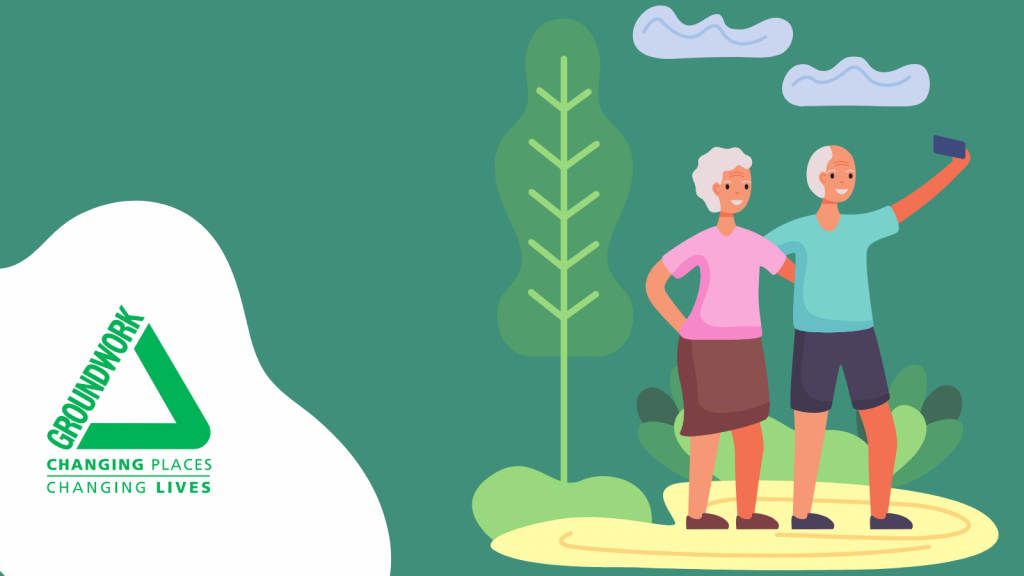
Earlier this year, the Get Yourself Active Team supported Groundwork UK with the Out Of Bounds report that was written on behalf of the National Outdoors for All Working Group. Fay Holland, policy and research executive from Groundwork UK, and Anna Denham, Get Yourself Active Programme Manager, have co-authored this blog about the benefits of getting outdoors and to share some tips that might help us all as the days get shorter.
With the nights drawing in, it’s easy to spend more time inside – especially when your days are packed with work, study or caring responsibilities. The colder weather and shorter daylight hours mean that many people are less active in the winter and spend less time connecting with nature. But spending time outside is vital for our mental and physical wellbeing and we all need to find ways to incorporate it into our days, whatever the weather.
Getting outdoors in the fresh air can be an excellent way of keeping active, in addition to connecting with nature. At Get Yourself Active, we know that many people prefer going for a walk, wheel, or cycle in their local park or woodland, to pumping iron in the gym. For many, you can’t beat the sights, sounds, and smells of nature when it comes to getting that feel-good factor that comes with doing exercise. However, we also know that exercising outdoors, or even getting to the great outdoors, isn’t that straightforward for everyone.
Laying the Groundwork
Earlier this year, Groundwork collaborated with a wide range of organisations, including the Get Yourself Active team at Disability Rights UK, to explore the barriers some groups experience to engaging with nature in our towns and cities. Our Out of Bounds report found that some neighbourhoods don’t have enough green space and, even where there are parks and nature reserves nearby, getting out into them can be easier said than done.

We found that people from different demographic groups experience complex barriers to spending time in nature, including:
- Relevance: sometimes parks and their facilities aren’t relevant for what people want to use them for;
- Accessibility: there can be physical barriers that prevent some people from using parks, and a lack of local public transport or walking and cycling routes can make it harder still;
- Safety: some people don’t feel safe or welcome in parks and green spaces, particularly when it’s dark.
We spoke with several Disabled People’s User Led Organisations, and Disabled individuals to find out a bit more about the barriers that many Disabled people encounter when trying to access their local green space.
From our conversations, we co-produced a series of case studies to accompany the Out of Bounds report and to bring home the reality of inaccessibility to green spaces. We found that it wasn’t just the accessibility of the areas themselves that was a barrier.
There were also barriers around getting to green spaces, such as a lack of blue badge parking or inaccessible public transport systems. However, the case studies were also positive in that many of the authors shared accounts of where they had successfully campaigned for change and greater accessibility. Change can happen, but it shouldn’t have to be a battle. Everyone has the right to access a local park or woodland or travel around town as they wish.
We want to see change, but we know that this, unfortunately, takes a very long time. And even when people can access their local green or blue space, it can feel challenging to build more time outdoors into your day, but small changes can make a big difference.
How small changes add up
Whether it’s taking your cup of tea into the garden, taking a more extended lunch to spend time in the local park, or planting bulbs ready for the spring, taking a moment to observe the nature around us can help to brighten the colder months. Thrive’s Autumn Wellbeing Calendar has 28 ideas for nature-based activities you can do as the days draw in.
If you find it hard to motivate yourself, it can help to share your goals with friends or colleagues.

For example, at Groundwork, we’ve been doing a ‘Winter Warmer Challenge’, where we use an app to record our activities, and it is added to a leader board. Knowing that other people are doing it can push us to get out the door. Meeting up with friends or family in the park is another excellent way to incorporate nature-based activities into your social life.
Getting active outdoors when and where you can is definitely a “two for one”. In addition to being a form of physical activity, walking or wheeling through the park can be an excuse to catch up with a friend. It can be a form of active travel, such as cycling through the park to get to the shops. It can be taking the dog for a daily walk.
We’ll keep raising awareness and campaigning for change so that everyone can access their local green space. Still, in the meantime, we hope that the Autumn Wellbeing Calendar offers some tips and ideas for everyone to be able to enjoy the beauty of nature.
Some Helpful Links:
- Thrive’s Autumn Wellbeing Calendar
- Out of Bounds report
- Zanib’s story about advocating for accessible journeys to and from natural spaces
- Kay’s story about challenging inaccessible cycle infrastructure
- Our final case study for the National Outdoors for All Working Group (NOfAWG) – Wheels for Wellbeing